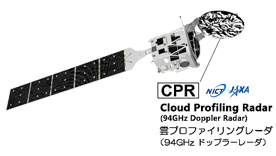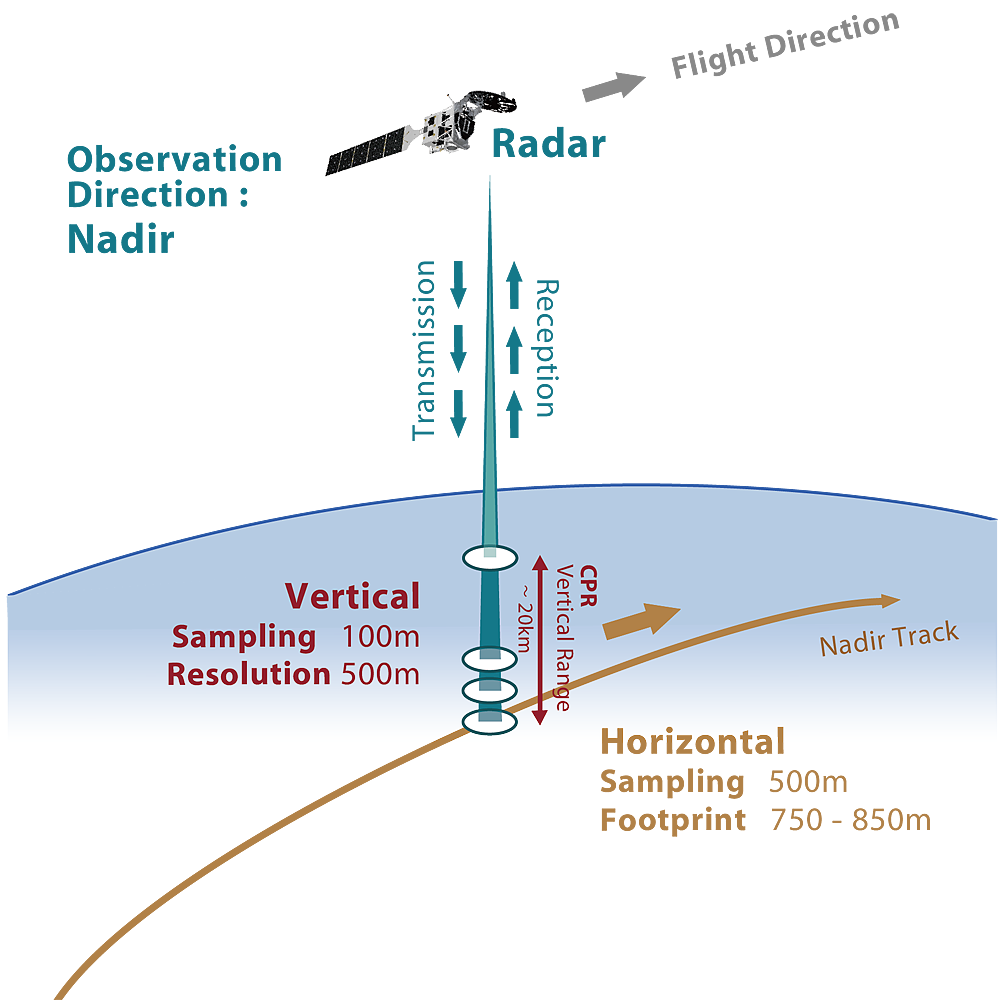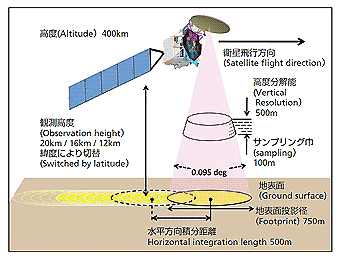CPR directly measures the intensity and phase information of backscattered signals from clouds and rain, obtained as a vertical profile directly below the satellite. These are corrected by a Level 1 algorithm considering transmission power and receiver gain and converted to values used to obtain the radar reflection factor, Doppler velocity, and Doppler spectrum width. After level 2 processing, such as atmospheric attenuation correction, Doppler fold-back correction, and 1 km and 10 km horizontal integration processing in the propagation path, converting to physical quantities provides estimated cloud mask, water content, ice content, effective particle radius of water and ice clouds, and optical thickness. Estimation algorithms are also being developed for precipitation-related (rain and snow) parameters and atmospheric vertical currents (vertical and settling velocities).
- Top
- Technical development
- Satellites and Observation Sensors
- Cloud Profiling Radar (CPR)
Cloud Profiling Radar (CPR)
Cloud Profiling Radar (CPR) is an active sensor that transmits pulses of radio waves in the millimeter band and receives vertical echoes (reflected and scattered signals) from clouds and rain. By sampling the echoes in response to the transmitted pulses at intervals, a vertical profile (i.e., vertical data distribution) of cloud and rain echo intensity can be obtained.*1 Further, measuring the phase change of the echo between two pulses (Doppler velocimetry) makes it possible to measure the rate of ascent or descent of clouds and rain particles.

Radar with Doppler measurement capability is often used on the ground, but the EarthCARE CPR is the world's first onboard satellite radar.
The sensitivity of radar echo detection is determined by wavelength, transmission power, antenna size, and distance to the object. EarthCARE's CPR is expected to detect 98% of ice clouds, which is important for the radiation budget.
Measuring the vertical Doppler velocity with CPR provides parameters that can be used to estimate the size of cloud and rain particles due to differences in their fall velocity and to discriminate between clouds, rain, snow, and drizzle. CPR is expected to significantly contribute to accounting for differences in radiation processes due to particle type.
The transmission pulse width determines the line-of-sight range of pulse radar. CPR transmits 3.3 μs pulses and has a vertical resolution of 500 m. CPR samples data at 100 m intervals to obtain more detailed vertical information.
The vertical detection altitude is switched between ground to about 20 km at low latitudes and ground to 12 km at high latitudes; clouds appear higher at low latitudes than at high latitudes. In addition, the pulse repetition frequency (PRF) varies from 6100 to 7500 Hz according to the satellite altitude for the highest possible PRF to improve the Doppler measurement accuracy.
Due to the limitation of data transmission capacity from the satellite to the ground, the echo intensity and Doppler information are sent to a ground station after a pulse integration of about 500 m in the direction of travel by the satellite, which means that the original horizontal sampling is every 500 m.
*1 Since the time it takes for the transmitted pulse to be reflected by clouds and rain corresponds to the distance to the satellite, a vertical profile of cloud and rain echo intensity can be obtained by acquiring data for each distance (each time) from the ground.CPR Observation Targets
CPR Data Products
CPR stand-alone observation data will be provided as L1b (created by JAXA), L2a echo (processed radar engineering data), and L2a cloud products (cloud distribution and physical characteristics). When combined with ATLID information, data on cloud and aerosol distribution and physical properties complemented by radar and lidar will be provided as L2b products. A single product file stores the main parameters of L2a and L2b, as well as the data for 1 km and 10 km horizontal integration distances.
CPR Research Products:
| Sensor type | 94 GHz (W-band) Doppler radar |
|---|---|
| Developer | Japan Aerospace Exploration Agency (JAXA) National Institute of Information and Communications Technology (NICT) |
| Center frequency | 94.05 GHz |
| Pulse width | 3.3 μs |
| Antenna beam width | < 0.095 deg. |
| PRF | 6100 to 7500 Hz (variable) |
| Sensitivity | < -35 dBZ at atmospheric top (10 km integration) |
| Doppler accuracy | < 1.3 m/s (10 km integration) |
| Measurement range | -1 to 12/16/20 km (depending on latitude zone) |
| Footprint (IFOV)(*2) |
< 750 m (depending on satellite altitude) |
| Horizontal sampling | 500 m |
| Vertical resolution | 500 m |
| Vertical sampling | 100 m (oversampling) |

